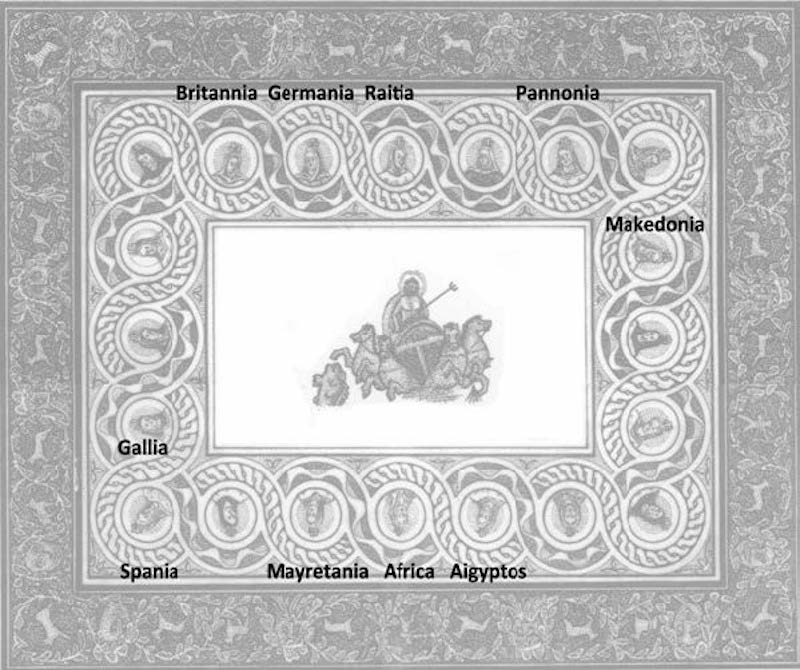From Syria to Jerusalem: The Roman Provinces in mosaic at the Terra Sancta Museum
At the Terra Sancta Museum – SBF Archaeological Museum it will be possible to admire three mosaics depicting the Roman Provinces of Africa, Mauretania and Germany, from the city of Zeugma (today, Belkis, in Turkey) and dating back to the second century AD (Antonine age). They will be set up in the Saller Wing, which bears the name of the Franciscan Sylvester Saller, a great American archaeologist who directed numerous excavations, such as those in the sanctuaries of Ein Karem, Bethany and Mount Nebo in Jordan, and was the first director of this museum in its current location.
A SINGLE MOSAIC
The three fragments belong to a single large floor mosaic of a house in the city of Hellenistic origin, which was called “Seleukia” in honor of its founder, Seleucus I Nicator, general of Alexander the Great, but which after the Roman conquest in 64 BC by Pompey changed its name to “Zeugma” and became part of the Roman Province of Syria.
Daniela Massara recounts in her study of these mosaics: “from the point of view of archaeological evidence from the Roman age, the best-preserved structures can be chronologically framed between the second half of the second century A.D. and the first half of the third century A.D.: it is in fact in this period that the many mosaic floors and frescoes that embellished residential buildings are dated”. It includes the floor mosaic whose fragments have become part of the museum’s collections, thanks to a private donation from the Marcopoli family of Aleppo.

A GIGANTIC JIGSAW PUZZLE
This mosaic, found in 1873 near the Acropolis of Zeugma and broken down into numerous fragments sold at antique markets or at auction (so much so that today they are preserved in different museums and private collections in numerous cities such as Jerusalem, Berlin, Dresden, Rome, Paris…), depicted the triumph of the god Neptune in the center, framed within two frames. one with allegorical representations of the Roman Provinces and the other with vegetable spirals, cupids and masks.

There are a total of ten fragments with Provinces that have been preserved of the original mosaic, and which are known until now: three are in the Terra Sancta Museum in Jerusalem (Africa, Mauretania and Germany); five in the Pergamon Museum in Berlin (Makedonia, Gallia, Spania, Raitia, Britannia); and two others are part of the private collection of the Poche family in Aleppo (Pannonia and Aegyptus).
THE ALLEGORY OF A HOMOGENEOUS ROMAN EMPIRE
The Provinces are depicted, each within a luminous circle called a “nimbus”, as female busts each accompanied by its own name in Greek characters (as a didascalie or caption). The faces are portrayed in three-quarter views and the hair is characterized by black and brown locks, partly covered by the veil; each Province wears a turreted crown, like the goddess of Fortune or Fate, the “Tyche”, considered the patron saint of the city. None of the personifications presents a particular characterizing element, except for Africa, which is the only one that, even if minimally (and as far as it is possible to understand from the available fragment), differs thanks to the dark tone of the complexion.

The expressiveness of the face shows two variations: the Province of Mauretania has its head slightly bowed and its gaze turned upwards, while the Provinces of Africa and Germany have a firm and straight gaze.
It is a common interpretation of archaeologists that these depictions of the Provinces of the Empire are a political-geographical allegory of the great Roman Empire; it would therefore be only one of the many examples of artistic testimonies of the Roman era indicating the desire to show an idea of the empire as an oikoumene (the civilized world or inhabited world) in which the individual geographical entities are constitutive elements of a single culturally homogeneous whole.

COMPARE STYLES AND TECHNIQUES
There are many iconographic comparisons with the mosaics from Zeugma. These include the mosaic of the Provinces found in the thermal building of Ostia, dating back to the second half of the first century A.D. and depicting Africa, Sicily, Egypt and Spain; the mosaic depicting the personification of Cilicia from the city of Seleucia, dating back to the II-III century A.D. and now preserved at the Sam Noble Museum (Oklahoma); and the round mosaic with the bust of the goddess Fortuna/Tyche from Beit Shean, dating back to the sixth century A.D. and now on display at the Israel Museum (Jerusalem). These examples of comparison are significant as they allow us to understand how the same subject can be represented through different styles, techniques and criteria depending on the creators, the location and the chronology.
For more information on the entire floor mosaic, see: Il Mosaico con Province da Belkis-Zeugma. Una riconsiderazione a partire dai frammenti di Gerusalemme, di Daniela Massara, pubblicato all’interno del volume miscellaneo Tra Servizio Civile e Missioni Estere: il contributo dell’Italia ai Beni Culturali della Terra Santa, 2014 (https://edizioniquasar.it/products/30).



